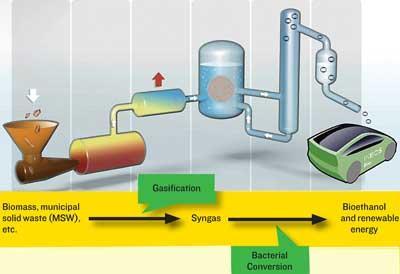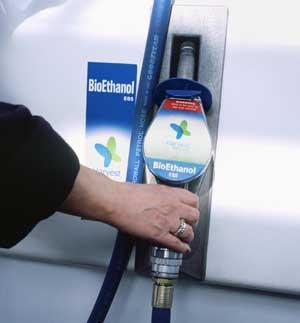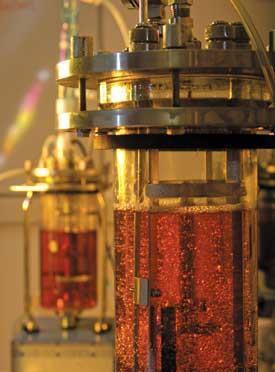The chemistry to convert waste into fuels is now being tested at pilot plants around the world. We may have the science, but are governments and industry ready, asks Emma Davies
The chemistry to convert waste into fuels is now being tested at pilot plants around the world. We may have the science, but are governments and industry ready, asks Emma Davies
What’s to be done with the mountains of rubbish that we generate now that our landfill days are drawing to a close? Many countries such as Denmark opt to burn waste to create electricity, but UK councils proposing to build such energy-from-waste plants - often in open countryside - face fierce local opposition.
Much of the waste burned contains valuable carbon atoms. ’If we take cellulosic material and simply burn it to generate electricity we put 30 per cent of carbon atoms up the chimney - it’s a criminal waste,’ says Jeremy Tomkinson, CEO of the National Non-Food Crops Centre (NNFCC) in York, UK. But there is an alternative to suit town councillors and environmentalists alike - using waste to create biofuels (and other chemicals) and energy.
Ineos Bio, created in July 2008 as a subsidiary of UK chemical company Ineos, claims to be ready to convert waste into biofuel on a commercial scale. ’We’re intending to take waste materials - including the biodegradable portion of household and commercial waste - and convert them into clean, renewable transport fuel and renewable power,’ explains Graham Rice, external relations and development manager at Ineos Bio. ’The vision is to create integrated biorefineries so that we can take raw residual waste, extract the recyclable materials for recycling, and convert the biodegradable portion into bioethanol and power.’

The company has ’advanced plans’ to build commercial biorefineries in North America and Europe. These will initially produce 20,000-30,000 tonnes of bioethanol per annum. Key to its technology platform is the waste-to-ethanol process that was developed by chemical engineer James Gaddy of Bioengineering Resources Inc (BRI), and which combines thermochemical and biochemical technology. First, organic matter is gasified using oxygen to produce syngas, a mixture of CO and H2. This is quenched and cleaned and heat is recovered to generate renewable power. Clostridium ljungdahlii bacteria ferment the gas at room temperature to create ethanol which is purified to give anhydrous ethanol (more than 99.7 per cent pure). It takes minutes to produce ethanol from the feedstock, compared with more than a day for conventional processes, says Rice.
BRI first built a pilot fermentation plant in Fayetteville, Arkansas, US, in 1994 and added a gasifier in 2003. Gasification gives great feedstock flexibility: ’We can take any feedstock with carbon in it to produce syngas,’ says Rice.
’The technology is ready for commercialisation,’ he adds. ’The key challenge is that it’s a capital intensive technology compared with first generation bioethanol, where the capital costs are lower but production costs are much higher.’
The size and location of the first Ineos Bio plant is under wraps. ’We’ve got sites identified but the global downturn has made it more difficult to get financing for the technology for new projects. So our aspirations have been slowed but we’re determined that we will get through,’ says Rice.
’This is Tomorrow’s World stuff - it’s fantastic,’ says Tomkinson. ’It is a perfect example of where I would see advanced biofuels entering the market in the near-mid term.’
Coupling gasification to fermentation sets Ineos Bio apart. Most biofuel producers use one or the other. The fermentation processes can only deal with one feedstock type at a time. During pre-treatment of the biomass, brute force - such as steam or acid - releases cellulose from lignin. Hydrolysis using costly cellulase enzymes is then needed to free the sugars. Alternatively, gasification converts carbon in the biomass to syngas which can be used to make compounds such as methanol, ethanol or biodiesel (via Fischer-Tropsch). Gasification can even be used to make jet kerosene, says Tomkinson.
Steady as she goes
The biofuels industry is taking it slowly with next-generation biofuels, which are generally created from biomass waste. First generation biofuels, embraced by many governments as an easy way to ensure fuel security and improve green credentials, get a bad press. Most are created from sugar, starch or vegetable oil. Growing such feedstock crops on fertile farmland has sparked media outrage and public outcry and created a food versus fuel debate.
Many blame flawed biofuel models for some of the bad press. ’The arguments about indirect land-use change during the past year are essentially entirely economic and I’m not sure if that’s understood by the general public,’ says Chris Somerville, director of the Energy Biosciences Institute (EBI) in the US. ’It’s all based on general equilibrium economic models which in turn are based on fairly skimpy data.’

The institute, a partnership between BP, the University of California, Berkeley, the Lawrence Berkeley National Laboratory, and the University of Illinois, was set up at the end of 2007 using $500 million (?360 million) supplied by petrochemical giant BP. The EBI now has over 300 researchers and is ’very active in trying to understand the sustainability issues and environmental issues of biofuel production’, says Somerville. It has a large number of research projects on the next (second)-generation of biofuels.
’What we’re really after is a deep understanding of the whole problem rather than just a piece of it,’ says Somerville. In the US, the national goal for cellulosic biofuels is to produce more than 60 billion gallons by 2030, requiring a significant capital investment of more than $300 billion. ’Realistically, before that can happen you have to develop an integrated view of what the future looks like - that means everything from socioeconomics, trade policy, environmental policy, international trade, agronomy and microbiology to chemical engineering,’ says Somerville. He is concerned that companies are taking a risk if they start making the capital investment while the technology is still rapidly evolving. ’We’re trying to improve understanding to reduce the capital risk,’ he adds.
Nevertheless, next-generation biofuels are getting closer to large-scale commercial production. As with the first generation biofuels, the US is leading the commercial field. More than 20 US firms have declared their intentions to build cellulosic fuel plants, says Somerville. Verenium, a US biofuel company, appears to be ahead of the game, having ’entered the start-up phase’ at its 1.4 million-gallon-per-year demonstration-scale facility in Jennings, Louisiana, to produce ethanol from non-food cellulosic biomass. In February, BP and Verenium announced a 50-50 joint venture to develop and commercialise cellulosic ethanol from non-food feedstocks. The companies intend to progress the development of one of the first commercial-scale cellulosic ethanol facilities, in Highlands County, Florida.
The US is very attractive to biofuels producers. ’It’s a no-brainer from an investment point of view,’ says Tomkinson. ’You’ve got all the feedstock sitting on your doorstep and a government that is concerned about national security and its hydrocarbon supplies and that puts huge grants on the table - up to $80 million. Nothing like that exists in Europe.’
China is also well advanced in biofuel production. It does not allow edible feedstock to be used for ethanol production. ’There is quite a big shift towards using cellulosic waste as feedstock,’ says Edward Green, founder and chief technical officer of Green Biologics, based in Abingdon, UK.
So it’s no surprise that UK biofuels companies are heading to the US and China to take the commercial leap forward. TMO Renewables, a biofuel company based in Guildford, UK, built the UK’s first cellulosic ethanol facility. It now plans to license out its technology, which includes a thermophilic bacterium first identified in compost: TM242. ’The initial plan is to work with existing corn ethanol plants in the US - there are over 170 to choose from,’ explains Steve Martin, TMO’s associate R&D director. Along with ethanol the plants produce a co-product called distiller’s grain which TMO can process to produce an extra 15 per cent ethanol. ’There’s an early opportunity for TMO to build a side-door plant on existing first generation ethanol plants to improve their productivity,’ says Martin.

TMO’s UK demonstration facility has been running for several years and the company has used it to test a wide range of feedstocks. ’The process is flexible enough that we can take various sources of feedstock - municipal waste, corn stover, corn cobs, straw, distiller’s grain, brewery waste and agricultural waste,’ says Martin. During fermentation TM242 produces some enzymes that help to degrade sugars. ’We find we use less enzyme than a lot of our competitors because the bug is doing some of the work itself,’ says Martin.
Future fuel
Some see ethanol as having a strong future in the fuel markets and there are companies, such as US-based Ricardo, that are improving engine technology to deal with ethanol more efficiently. ’Advances in ethanol engine technology, together with potentially lower production costs of bioethanol from waste compared to biodiesel, could result in a future shift towards increased sales of ethanol / petrol engine vehicles in Europe and reverse the recent trend towards diesel engine vehicles,’ predicts Rice of Ineos Bio.
But others see ethanol as only the first step for next-generation biofuels production. ’In the long term we don’t want ethanol,’ says Somerville. ’The real long-term goal would be to make fuel like diesel and gasoline - I don’t see any particular problem in making those from biomass.’
Tomkinson agrees: ’The oil companies are saying that ethanol is fine on a first generation basis but where are the mid-distillates: the diesel, heating oil, kerosene, etc coming from?’ The petrochemical industry is also interested in making biobutanol from cellulosic material and big names such as BP and DuPont are investing substantial amounts of money in this area. Butanol has a higher energy content than ethanol, is easily transported, and can be blended with petrol at high concentrations.
But the strains of bacteria currently used to produce biobutanol generate unwanted byproducts and are relatively inefficient. Moreover, they are unable to use lignocellulose directly as a feedstock. Nigel Minton, from the School of Molecular Medical Sciences at Nottingham University, UK, heads a biobutanol research programme for the Biotechnology and Biological Sciences Research Council (BBSRC) Sustainable Bioenergy Centre, set
up in January 2009 at a cost of
?27 million. ’The real drive is to make biobutanol cellulosic and we need to make the organism more efficient at degrading lignocellulosic material,’ he says.

Minton specialises in clostridia bacteria and is working with TMO Renewables on the BBSRC biobutanol project. ’We see biobutanol as a little further away [than ethanol]. We are investing so that if there’s a high market demand for butanol we’ll be able to deliver it,’ says TMO’s Martin.
Clostridia are anaerobes - organisms that survive without oxygen. ’Anaerobes have to develop efficient processes of breaking things down and generating energy,’ explains Minton. ’They have a system called the cellulosome, which is like a mini-organelle composed of many different enzymes which it uses to degrade cellulosic material. It’s recognised as being one of the most efficient systems known. What we want to do is to engineer that to make it better.’
This would enable a gentler and cheaper biomass pre-treatment. ’What you want is your process organism to actually produce those enzymes and degrade the cellulose all in one step,’ says Minton.
Green Biologics is also focusing on producing biobutanol using clostridia. China is proving fertile ground for it to develop its processes. ’Over the past 12 to 18 months butanol fermentation has been re-commercialised in China and there are now at least six commercial sites,’ says Green. ’They’re crying out for some technical improvement to their processes,’ he adds. Green Biologics is working with three Chinese companies ’looking to transfer some of our technology - improved microbes and some process knowledge.’
When Green Biologics started working in China approximately nine months ago, ’the economics looked really good and some of these plants had started to operate’, says Green. But falling oil prices have dragged down the value of butanol and the plants have halted production. Green is hopeful that his team can help the companies to turn things around. They are using glycerol - a byproduct of biodiesel - and molasses as feedstocks. ’We’re going through testing programmes with our microbes on their feedstocks. We’re working through a development programme and putting our technology onto the plants within the next three to six months,’ says Green. ’The great opportunity for us is that we can demonstrate our technology on a commercial scale.’
Green Biologics hopes one day to be able to use its thermophilic bacteria to produce butanol. Thermophiles grow much faster than clostridia, giving higher productivity. They also tend to be able to use a wider range of sugars as feedstock. ’The difficulty is that thermophiles don’t naturally produce butanol,’ explains Green. ’What we’re doing at the moment is carefully engineering those microbes. We have proved the concept and now the challenge is intensifying the process so that we can increase butanol yield.’
Where now?
The industry still has a long way to go but Somerville is cautiously optimistic about the future. ’It’s beginning here [in the US] but it’s going to take some time.’ He estimates that next-generation plants won’t be functioning at ’full technical capability’ for three years and that ’we’re not really going to have substantial cellulosic production for at least six years’. But he goes so far as to predict that ’we’ll ultimately get between one third and a half of all transportation fuel from cellulosic materials. I don’t think there’s much doubt that we can do that’.

If it’s going to take six years for next-generation biofuels to become established in the US, then what does the future hold for Europe? ’The main problem in the UK and the rest of Europe is feedstock and feedstock availability,’ says Green. ’We don’t have the huge corn belt that they have in China for example. Nor do we have mass agriculture. It’s my belief that the best feedstock opportunity in the UK and Europe is waste feedstocks - taking waste away from landfill.’

Tomkinson is convinced, based on evidence from research commissioned by NNFCC, that the future for the UK lies in thermochemical routes to biofuel production rather than fermentation. ’We don’t have enough of one feedstock for fermentation,’ he says. ’The conclusion that the big industries have come to is that it is likely that advanced biofuels in the UK and the EU will be thermochemical in the first instance. We might then develop fermentation capability further down the line.’
Another problem is that the UK doesn’t have much first generation biofuel capacity, says Green. ’We have some biodiesel capacity although most of that has shut down [due to large subsidies for US biodiesel producers]. We don’t have a first generation bioethanol industry on which to build. I think that’s the big weakness.’
Making the most of the biofuel byproducts is a must. This can be done by ’bolting process technology on the back end of a biodiesel plant or bioethanol plant such that you can use the waste streams,’ says Green. ’A good example is what we [Green Biologics] can do with glycerine. We can integrate a butanol process on the back end of a biodiesel plant and utilise the waste glycerine as a feedstock for butanol production.’
As with all sectors, the economic climate is having a negative effect on the biofuels industry. ’The cost of building biofuel plants is a major constraint,’ says Tomkinson. He is calling for a more stable policy environment in the UK and perhaps some government incentives for biofuels producers. ’The US model is a good one,’ says TMO’s Martin. Last year, he says, the US government put $1 billion into funding cellulosic ethanol and there are a number of very well-funded bioenergy centres. It cost almost ?8 million for TMO to build its demonstration facility, which it funded through private investment. ’My view is that we’re very good in the UK at investing in research. What we’re not that good at is supporting the transition from successful research into successful commercial - that’s the most expensive work for a company to take on.’
’I had a group of people around recently to visit the site and they were very excited by what they saw,’ says Martin. ’They had been led to believe that the technology is five to 10 years away and to actually see it working in front of them was quite a shock. A lot of people would like to think it’s five to 10 years away because it means they don’t have to take any action on it today but the truth is it could be here today if there was more support.’






No comments yet